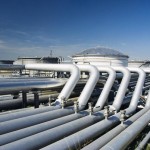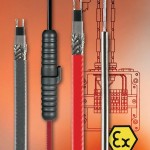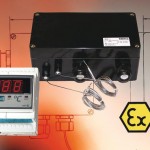The Lobau tank farm is one of the biggest tank farms in Austria. In order to remain on a state-of-the-art level of technology, the owner OMV regularly invests in its modernisation. One recent project was the engineering and supply of trace heating for the farm’s oil pipes. The target was to keep the temperature of the crude oils on a constant level as well as to avoid the pipes getting frozen.
The author: Michael Holzbauer Product Manager Heating Technology, Bartec
OMV can store around 1.63 million m3 of crude oils, semi-finished or finished products and additives in 81 tank containers in the Lobau tank farm. This volume is also used to bridge supply shortages if needed. The largest OMV tank can hold 130,000 m3 and the smallest 50 m3. The two mixing plants in the Lobau tank farm are remotely controlled. An optimi-sation computer continuously computes the best mixing formula. The operator closely monitors the interplay between online anal-yses and this optimisation. The petrol mixing plant delivers regular grade, Eurosuper and Super 100 fuel as finished products from petroleum components as well as semi-finished products for seasonal interim storage. The plant has a capacity of 600 m3/h. The middle distillate mixing plant produces diesel fuel and extra-light heating oil. After mixing, the finished products are subjected to further automated analyses.
In order to remain on a state-of-the-art level of technology, OMV regularly invests in the modernisation of the tank farm. Bartec, one of the leading providers of safety technology, succeeded in convincing OMV of its technical know-how and expertise. The company was awarded the contract for the engineering and supply of trace heating for the oil pipes in the tank farm.
Choice of heating cables
The cables chosen for the project were two self-limiting parallel heating cables called PSB and HSB. The advantage of these two cables is their suitability for use in potentially explosive atmosphere without a temperature limiter. There are consequently no costs for additional components. More than 2000 m of cable were laid.
Both cables have a temperature-sensitive resistive element between two parallel copper conductors, which regulates and limits their heat output according to the ambient temperature. This regulation takes place automatically along the entire length of the heating cable. As the ambient temperature rises, the heat output is reduced. This self-limiting property prevents overheating even if the cables are overlapped. A temperature limiter can be dispensed with, even in hazardous areas such as the Lobau tank farm. Thanks to the parallel power supply, the heating cables can be cut to any required length. This considerably simplifies project planning and installation. The heating cables are cut and terminated directly on the construction site in accordance with local requirements. If ever a cable is damaged, only the affected part and not the whole circuit need be replaced. The protective outer jacket, made of either fluoropolymer or polyolefin, protects the inner copper braiding from corrosion and chemical attack. The copper braiding serves as an earthing conductor in accordance with VDE 0100 and improves the cable’s mechanical stability. Underneath the protective braiding are two synthetic jackets for electrical insulation. The inner of the two jackets is thermally fused to the heating element (bonded jacket).
Connection technology
Since the related equipment to the heating pipes also had to be certified for applications in hazardous areas, there were two options for connecting the PSB and HSB heating cables: the heat shrink Ex connection technology and the Plexo connection system. The heat shrink Ex connection technology is a reliable solution for connecting heating cables. The principle is easy. After stripping the heating tape, insulation tubes are shrunk over the supply lines and the twisted protective braiding and wire end sleeves attached. The heating cable is always connected to terminals in an enclosure with the ’increased safety’ or ’flameproof encapsulation’ type of protection. The end of the heating circuit is likewise closed with shrinkable tubes. By contrast, Plexo, the first plug-in connection system for heating cables installed in potentially explosive atmosphere, offers a substantial reduction in installation time and expense. Maintenance work on the heating circuit in case of future modifications can be carried out more efficiently. The connection system is optimally suited for self-limiting parallel heating cables. The heating and power supply cables are connected via a safe spring that provides the necessary pressure, so that there is no need for unravelling or twisting. The sophisticated sealing system affords safe and reliable protection against adverse weather conditions. The system’s flexibility allows the heating cable to be directly connected to a supply cable or an Ex junction box. Two identical heating cables can be joined together using a plug-and-socket ’splice’ sleeve. The remote termination of the heating tape can be equipped with plug-in contacts to permit future extensions of the heating circuit. OMV was persuaded by Plexo’s many beneficial features. The connection system met the requirements for the application in the Lobau tank farm perfectly.
In addition to this, 2000 m of EMK, a single-core mineral-insulated heating cable, were also used. This cable is extremely robust and thus requires no extra protection. Heat is generated when supply voltage is applied to the resistance cable. The amount of heat depends on the cable’s resistance and the supply voltage. The high constant power output per metre, high resistance to tension-crack corrosion and extremely good chemical resistance were other factors that make the cable ideal for use in a waste incineration plant. Connection kits that were specifically designed for EMK and its particular fields of application were employed to connect the single-core mineral-insulated heating cable. These EMK connection kits consist of heating circuit junction boxes for the required power supply connection, cold leads and hot-to-cold joints in the required quantity.
More than just heating cables
As a system provider, Bartec not only supplied the heating cables and the connection kits but also the requisite control technology. OMV thus acquired a complete solution from one source. The BSTW safety temperature monitor used for this purpose is a 16 A Ex change-over controller housed in an EEx e certified polyester enclosure. Heaters, fans, motors and other equipment are switched on and off by means of this thermostat if a specific temperature range is exceeded. This device can also be used to control the temperature in air or liquids as well as on various surfaces. Any change in temperature at the sensor bulb causes a change in the volume of fluid in the measuring system, which in turn results in a movement of the membrane. The membrane is connected to a mechanical device that operates a micro switch. If the temperature at the sensor bulb exceeds the preset, terminals 1 and 4 are opened.
Furthermore, the DPCex temperature controller for use in hazardous areas was implemented in combination with Pt100 sensors. It is particularly suitable for controlling electric pipe heaters. Temperature changes at the Pt100 sensor are evaluated by the DPCex and indicated as actual values on the LED display. If the high or low temperature limit is exceeded at the sensor, the output relay is automatically switched on or off. The hysteresis between the switch-on and switch-off points is settable. The switch points of the two relays can be set independently of one another as high and low temperature alarms.
Hall 11.1, Booth E76
cpp-net.com/0212462
Share:









